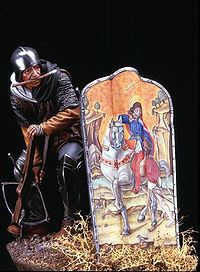
Pavise
Encyclopedia

Shield
A shield is a type of personal armor, meant to intercept attacks, either by stopping projectiles such as arrows or redirecting a hit from a sword, mace or battle axe to the side of the shield-bearer....
of Europe
Europe
Europe is, by convention, one of the world's seven continents. Comprising the westernmost peninsula of Eurasia, Europe is generally 'divided' from Asia to its east by the watershed divides of the Ural and Caucasus Mountains, the Ural River, the Caspian and Black Seas, and the waterways connecting...
an origin used to protect the entire body. The pavise was also made in a smaller version for hand to hand combat and for wearing on the back of men-at-arms. It is characterized by its prominent central ridge. The concept of using a shield to cover an archer dates to at least to the writing of Homer
Homer
In the Western classical tradition Homer , is the author of the Iliad and the Odyssey, and is revered as the greatest ancient Greek epic poet. These epics lie at the beginning of the Western canon of literature, and have had an enormous influence on the history of literature.When he lived is...
's Iliad
Iliad
The Iliad is an epic poem in dactylic hexameters, traditionally attributed to Homer. Set during the Trojan War, the ten-year siege of the city of Troy by a coalition of Greek states, it tells of the battles and events during the weeks of a quarrel between King Agamemnon and the warrior Achilles...
, where Ajax
Ajax (mythology)
Ajax or Aias was a mythological Greek hero, the son of Telamon and Periboea and king of Salamis. He plays an important role in Homer's Iliad and in the Epic Cycle, a series of epic poems about the Trojan War. To distinguish him from Ajax, son of Oileus , he is called "Telamonian Ajax," "Greater...
uses his shield to cover his half-brother Teucer
Teucer
In Greek mythology Teucer, also Teucrus or Teucris , was the son of King Telamon of Salamis Island and his second wife Hesione, daughter of King Laomedon of Troy. He fought alongside his half-brother, Ajax, in the Trojan War and is the legendary founder of the city Salamis on Cyprus...
, an archer, while he would "peer round" and shoot arrows.
The pavise was primarily used by archers
Archery
Archery is the art, practice, or skill of propelling arrows with the use of a bow, from Latin arcus. Archery has historically been used for hunting and combat; in modern times, however, its main use is that of a recreational activity...
and crossbow
Crossbow
A crossbow is a weapon consisting of a bow mounted on a stock that shoots projectiles, often called bolts or quarrels. The medieval crossbow was called by many names, most of which derived from the word ballista, a torsion engine resembling a crossbow in appearance.Historically, crossbows played a...
men in the medieval
Middle Ages
The Middle Ages is a periodization of European history from the 5th century to the 15th century. The Middle Ages follows the fall of the Western Roman Empire in 476 and precedes the Early Modern Era. It is the middle period of a three-period division of Western history: Classic, Medieval and Modern...
period, particularly during siege
Siege
A siege is a military blockade of a city or fortress with the intent of conquering by attrition or assault. The term derives from sedere, Latin for "to sit". Generally speaking, siege warfare is a form of constant, low intensity conflict characterized by one party holding a strong, static...
s. It was carried by a pavisier, usually an archer, or, especially for the larger ones, by a groom. The pavise was held in place by the pavisier or sometimes deployed in the ground with a spike attached to the bottom. While reloading their weapons, crossbowmen would crouch behind them to shelter against incoming missile attacks.
Pavises were often painted with the coat of arms of the town where they were made, and sometimes stored in the town arsenal for when the town came under attack. Religious icons such as St. Barbara and St. George were featured on the front of pavises. Even the Hussite
Hussite
The Hussites were a Christian movement following the teachings of Czech reformer Jan Hus , who became one of the forerunners of the Protestant Reformation...
chalice was featured on pavises during the Hussite Wars
Hussite Wars
The Hussite Wars, also called the Bohemian Wars involved the military actions against and amongst the followers of Jan Hus in Bohemia in the period 1419 to circa 1434. The Hussite Wars were notable for the extensive use of early hand-held gunpowder weapons such as hand cannons...
. Most pavises were covered in a coarse, carpet base like canvas, before being painted with oil and egg-based paints. Only 200 or so exist today but many were present in the period.
A related term, pavisade or pavesade, refers to a decorative row of shields or a band of canvas hung around a sailing vessel to prevent an opponent from observing the activities of those on board and to discourage boarding.
External links
- 15th Century Pavises (myArmoury.com forum topic)
- The Shield: An Abridged History of its Use and Development (myArmoury.com article)

